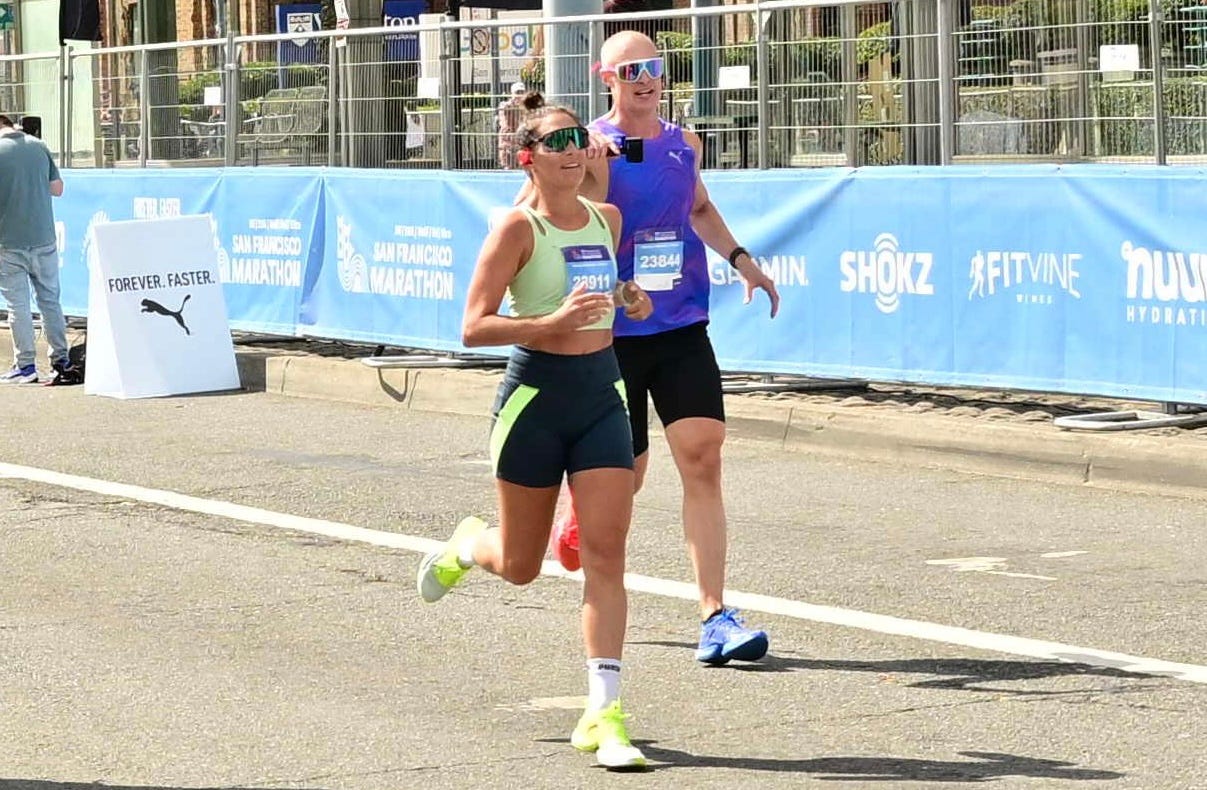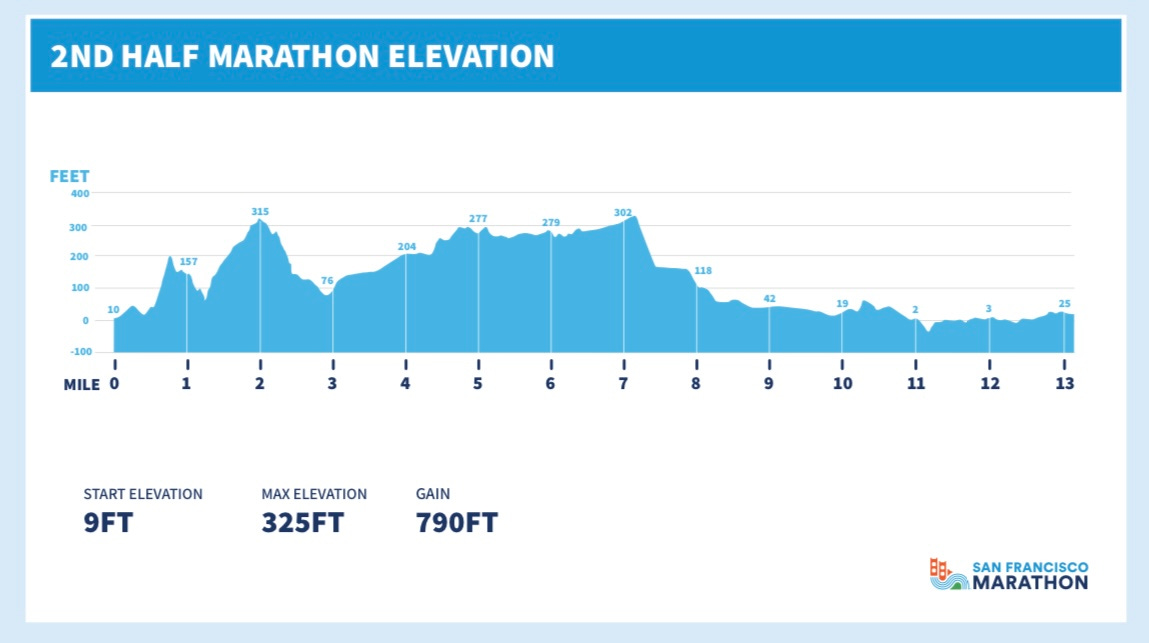When I ran the San Francisco Half Marathon in 2017, I did the first half—the one that includes running across the Golden Gate Bridge. It’s arguably the “prettier” half of the two, but when PUMA offered me a chance to participate in the SF Marathon race weekend this year, I opted for the second half. For one, I generally try to avoid running uphill at all costs, and the second half promised 790 feet of elevation gain compared to 1,455 in the second, making it the faster half by far. I also liked the idea of going back to “finish” the full marathon distance (that’s not quite how the routes line up, but oh well.)
After the mess that was this year’s Slacker Half Marathon (and taking almost a full month to recover), I went into this half marathon with only one goal: have fun and feel good. That mostly worked out!
The race started at 8:15 a.m., which was great because I didn’t have to get up at the crack of dawn and I actually had time to do a short warmup I always say I’m going to do on race day before jumping into the corrals at Crissy Field, a former army airfield on the northern shore of the San Francisco Peninsula overlooking the bay. I was in corral C, but the pacer signs showed times way behind my preferred half marathon pace, so, with Drew Whitcomb from WearTesters, I slowly worked my way up closer to the front in the hopes that we wouldn’t get caught up in the pack.
It didn’t look super crowded, but once the gun went off, we still had to weave around people for a few minutes. Once we started gaining elevation, though, the crowds thinned out—and as soon as they did, we were treated to gorgeously moody views of the Golden Gate Bridge and the San Francisco Bay.
I knew the first two miles were going to be rough; the course showed that we would gain over 250 feet in two steep climbs. It was a kind of nice way to keep my pace in check and hold me back from going out too fast, but I was *working* to get up those hills. I do think all the trail running I’ve been doing this summer paid off. I didn’t feel as gassed as I normally would, although a few more hill-specific workouts may have helped and I could definitely feel the 86 percent humidity!
Mile 3 was a screaming downhill, with 220 feet of descent—my favorite kind of mile! It felt so good to open up my stride after those first two miles, and the views of the coastline were absolutely stunning.
From there, we settled into a steady climb out of the Presidio through the Sea Cliff neighborhood into Golden Gate Park. This was where we synced up with the runners from the first half marathon, who were reaching mile 11 (and I actually remembered seeing my friends spectating at this part of the course back in 2017!). The hills didn’t let up once we were inside the park, so the crowds at the first half marathon finish line—which coincided with mile 5.5 for us—were a super welcome boost of energy, although there’s nothing more demoralizing in the middle of a race than watching other runners stop their watches.
Once we left the park, this part of the race earned its moniker, the City Half Marathon. Miles seven to nine were a smooth downhill, taking us past historic Victorians and through the quirky 1960s vibes of the Haight-Ashbury neighborhood before dropping us into the Mission, where we could smell Mexican food over the “constant eucalyptus” the race description promised (that was not a bad thing!).
I was pretty zoned out from my surroundings during this section, because I had a cramp develop around the halfway point that graduated to the sensation of a stake stabbing from my abs to my lower back. Fun! I tried all my tricks—lifting my arms, breathing out hard every time my right foot hit the ground, digging my hand into my stomach to apply pressure to the cramp—but nothing seemed to make it any better, except slowing down to a walk. To say this was frustrating would be an understatement; I had felt great during the first half, and my legs were barely feeling the effort. But this totally derailed me, and I had to keep reminding myself that there was no time goal in mind.
Around mile 11, we hit the water and turned on to the Embarcadero, and my cramp finally started to dissipate (it never fully did; it left a sort of lingering hangover cramp that was less bad but not great?). Was it because I drank a Bud Light someone offered? Maybe! I was fueling throughout the race, but maybe I needed the extra sodium and carbs from the beer. Also, the goal was fun. Why not chug a cup of beer when you’re that close to the finish?
The Embarcadero took us past the Golden State Warriors and the San Francisco Giants stadiums to the left and panoramic views of the Bay Bridge to the right. The overcast weather that had been forecasted had turned into a super sunny day, so the bay breezes were exceptionally welcome at this point. This was also the first part of the race since the halfway point with significant crowds, so that spectator energy was a nice boost into the final mile.
I need to do more races that end alongside the beach—or major tourist promenades—because this scene really helped me find that finishing kick. It wasn’t my fastest race, but it wasn’t my slowest, and it definitely felt way better than my last one (and my legs even felt great on the three-mile cooldown!). I’m considering this a solid long run workout that’s much more in line with how I envisioned kicking off marathon training. And now we keep building!
the rundown
Nike Zegama
The fact that the Nike Zegama uses ZoomX foam—which so far has been reserved mostly for the brand’s speedier road shoes like the Alphafly and Vaporfly—got me super excited to try these on trails. And they were good! But not great. I just felt like I wanted…more from these. I did like the stack height, the stability the engineered mesh upper offered, and the wide lug pattern was sticky enough. But, honestly, I’d probably still opt for the Pegasus Trail (I recently tested the Pegasus Trail 4 GORE-TEX) over these, because they have better traction and feel more familiar.
Supplements May Not Be What They Seem
As someone who’s nutrition is…a work in progress, this was alarming: A recent research letter published in JAMA tested 57 sports supplements and found that 40 percent didn't contain any of the substances on the label; 49 percent had the wrong amounts of the listed ingredient compared to 11 percent that listed the correct quantity, and seven 12 percent had illegal additives (!). I’m not anti-supplement by any means—I’ve taken several, under the direction of a doctor, for measurable deficiencies in my blood work—but this is a good reminder that these aren’t shortcuts; it’s best to get your nutrients from real food, and, if you are going to take supplements, do your research on them!
Nike Aerogami Jacket
Sorry to double down on Nike today, but the Swoosh just announced a brand-new, high-tech jacket that regulates your body temperature “on demand” while you run. It has a venting system that opens up as sweat builds up on your skin, and closes back up once you start cooling down. The vents are strategically located across the chest and back, as well as high-sweat areas specific to gender (i.e. around the sports bra area for female runners), and you don’t have to adjust a single zipper to get more air. It’ll be available this fall.
Keira D’Amato on Citius Mag
Listening to Keira D’Amato never gets old. She was recently on the Citius Mag podcast talking about breaking the American record in the half marathon, and I’m always so inspired by how real she is during interviews. She talks a lot about her uncertainty and doubts going into the Asics Half Marathon in Gold Coast, Australia, which I think is something all runners can relate to. But, despite having pulled out of the London Marathon relatively recently, that hope for something big was still there—and she managed to pull out an incredible performance. I’d recommend listening to this one right before race day.








I’m in The Rundown’s header image!